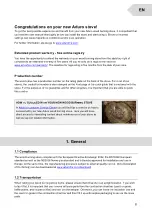
43
5. Maintenance and cleaning of the stove
Combustion chamber
The fireproof tiles in the combustion chamber eventually wear out and should be replaced when the cracks
are more than 0.5 cm wide. The durability of the tiles depends on how often and how intensively the stove is
used.
You can change the tiles yourself.
They are available as a ready-to-use set. You can buy the sets at
Glass
Wet wood, unsatisfactory chimney draft, and wrong use of the stove can leave soot stains on the glass
panes. It can easily be removed using a damp cloth that you dip in cold ash and rub on the sooty glass.
Special cleaning agents are also available to remove soot from glass, e.g. the
. The
pad neither scratches nor damages the glass and is for multiple usage. Water or other cleaning agents are
not necessary.
It is common maintenance to tighten the glass fittings and the hinges shortly after the stove has been
installed.
Gaskets
Check if the gaskets around glass and door are properly placed. Over time, the gaskets will wear out and
should therefore be checked regularly. If leakages appear, they should be replaced, as it is essential that the
stove is tight.
Adjusting the door
Adjusting the door and the closing mechanism is a necessary part of the maintenance of the stove, which
you can easily do yourself. If the door hangs on one side, feels sluggish to close or does not close properly,
you should adjust and tighten the hinges and fittings around the door.
Ashes
Empty the ashpan before it gets completely full but always leave a layer of ashes in the combustion chamber
because it insulates and makes it easier to light a fire next time.
Cleaning the stove
The stove’s surface will stay at its best just by being vacuumed with a small, soft mouthpiece or dusted with a
soft, dry cloth. Do not use spirit or other solvents, as they will remove the paint.
All maintenance and cleaning of the stove should be carried out when
the stove is cold.
Do not clean the stove with water. If the stove is exposed to moisture, the
stove may develop rust.
















































